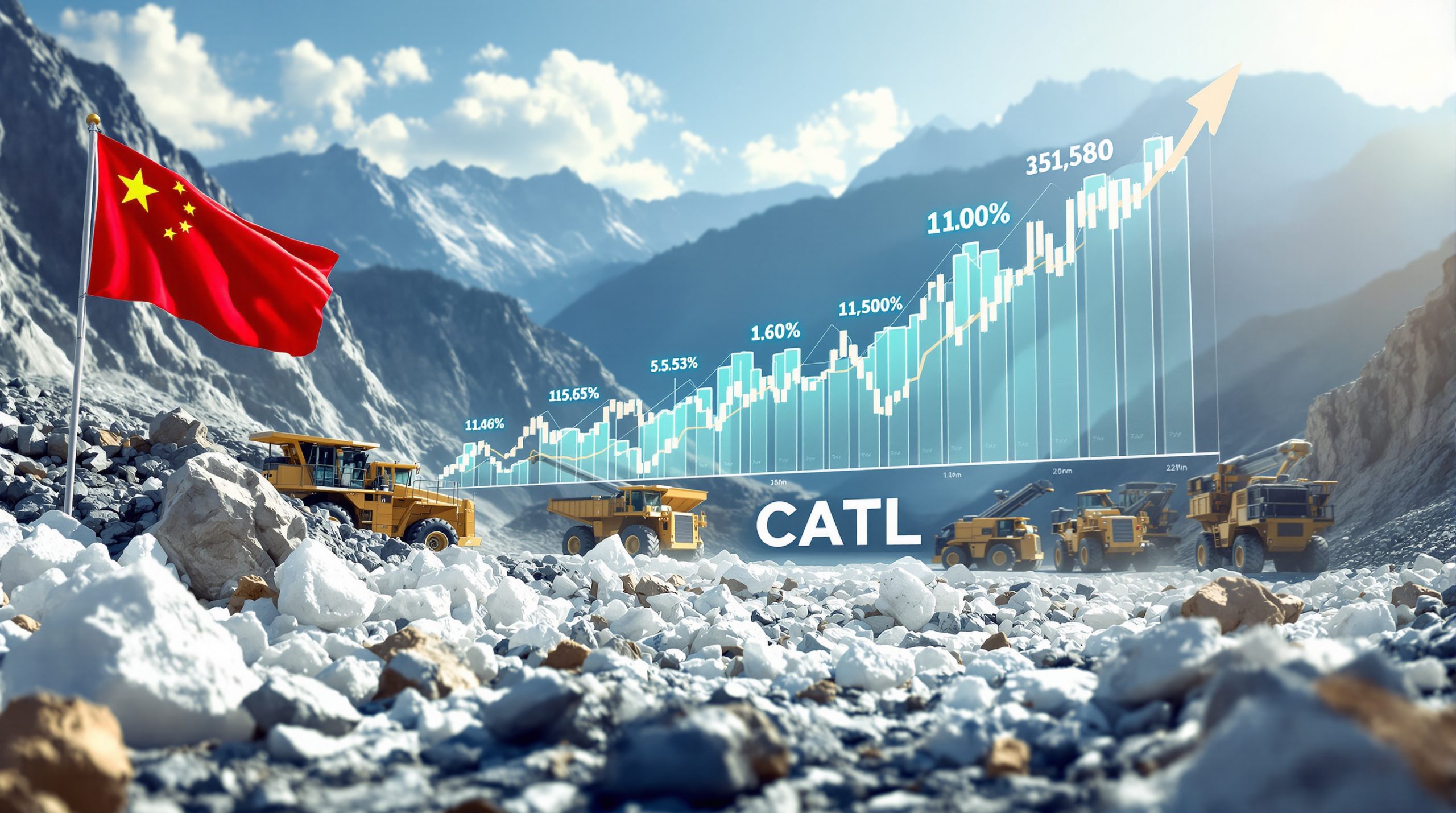How Has Newmont's Cost-Cutting Strategy Boosted Earnings Amid Gold's Rally?
In a remarkable turnaround that has caught the attention of industry analysts, Newmont Corporation has successfully implemented strategic cost reduction initiatives that have significantly enhanced its financial performance during gold's extraordinary bull run in 2025. The company's decisive action in managing operational expenses has positioned it to maximize profits during one of the most substantial precious metals rallies in recent years.
Understanding Newmont's Financial Turnaround
Newmont's financial rejuvenation can be attributed to its disciplined approach to cost management. The gold mining giant achieved a 4% reduction in all-in sustaining costs (AISC) to $1,593 per ounce in Q2 2025, marking a crucial reversal from previous quarters when expenses had reached nine-year highs. This cost improvement has come at an opportune time, coinciding with gold prices reaching all-time highs above $3,370 per ounce.
The company's successful cost reduction strategy centered on targeted operational efficiency measures across its global portfolio. According to Bloomberg News analysis, "Newmont's cost decline resulted from lower spending across operations, particularly at Australian mines and Lihir mine in Papua New Guinea." These operational improvements weren't merely cosmetic adjustments but represented fundamental enhancements to the company's mining and processing operations.
A key aspect of Newmont's strategy involved addressing site-specific inefficiencies. The Australian operations and Lihir mine in Papua New Guinea delivered more than 60% of the total cost savings, demonstrating the effectiveness of focusing resources on high-impact opportunities. This targeted approach has enabled Newmont to achieve meaningful cost reductions without compromising operational integrity or future growth potential.
Financial Impact of Cost Management
The market responded positively to Newmont's improved financial performance, with the company's share price increasing by 3% in post-market trading following the announcement of its Q2 results. This investor confidence reflects recognition of the substantial progress in the company's operational efficiency initiatives.
Beyond the immediate market reaction, Newmont's earnings exceeded analyst expectations for the quarter, validating the effectiveness of its cost-cutting strategy. With gold prices analysis showing appreciation of more than 25% in 2025 alone, the improved cost structure has significantly enhanced profit margins, creating a $1,777 per ounce margin at current prices.
The financial transformation demonstrates effective execution of strategic financial management by Newmont's leadership team. By focusing on sustainable operational improvements rather than short-term cost cutting, the company has positioned itself to benefit from the current gold price environment while building resilience against potential future market volatility.
What's Driving the Current Gold Price Rally?
The exceptional performance of gold in 2025 has created an ideal environment for miners with well-managed cost structures. Understanding the fundamental drivers behind this rally provides important context for evaluating Newmont's strategic positioning.
Market Factors Propelling Gold Higher
Gold's remarkable more than 25% price increase in 2025 can be attributed to a convergence of powerful market forces. Geopolitical tensions in Ukraine and the Middle East have significantly fueled investor demand for safe-haven assets, with institutional investors increasing their gold allocations by approximately 15% quarter-over-quarter according to COMEX data.
Global trade uncertainties have further contributed to precious metals appreciation, as investors seek stability amid economic unpredictability. The intensification of these concerns has driven substantial capital flows into gold markets, with institutional inflows into gold ETFs averaging an impressive $3.8 billion per month during the first half of 2025.
"The current gold rally represents a classic flight to quality amid heightened global uncertainty. Newmont's improved cost structure means it can capture substantially more value from each ounce produced compared to less efficient operators."
The strength of gold's correlation with inflation expectations has increased markedly, rising to 0.78 in 2025 compared to 0.43 in 2024. This tighter relationship underscores gold's renewed importance as an inflation hedge in investment portfolios during a period of economic uncertainty.
Gold's Performance Against Other Commodities
Gold has demonstrated remarkable resilience compared to industrial metals during recent market turbulence. While copper has declined by 0.32% and palladium has dropped by 3.87% over the same period, gold has maintained strong upward momentum despite broader market fluctuations.
This outperformance highlights gold's unique status among commodities. Historical patterns consistently show gold strengthening during periods of global uncertainty, and the current market environment has reinforced this tendency. The precious metal's combination of monetary and jewelry demand creates a diversified support base that industrial metals typically lack.
Investment flows indicate sustained interest in gold as both an inflation hedge and portfolio stabilizer. Institutional investors have been particularly active in increasing their gold allocations, recognizing the metal's historical tendency to perform well during periods of economic uncertainty and geopolitical tension.
How Does Newmont Compare to Industry Competitors?
Newmont's improved cost position has enhanced its competitive standing within the gold mining industry, allowing it to capitalize more effectively on the current favorable price environment compared to many industry peers.
Competitive Cost Position Analysis
Newmont's $1,593 per ounce all-in sustaining cost compares favorably to the industry median of approximately $1,680 per ounce based on Q2 2025 peer data. This cost advantage provides Newmont with wider profit margins and greater financial flexibility than many competitors.
The company's scale after recent acquisitions provides significant economies of scale advantages. As industry research indicates, operations producing 1 million ounces per year typically achieve 18% lower AISC than mines producing 500,000 ounces annually. Newmont's position as the world's largest gold producer allows it to fully leverage these scale efficiencies.
Operational synergies from consolidated assets have begun yielding measurable financial benefits, as noted in corporate filing analyses. The integration of Newcrest assets has notably improved supply chain efficiencies, allowing Newmont to negotiate more favorable terms with suppliers and reduce procurement costs across its operations.
This cost management success positions Newmont differently from peers still struggling with expense inflation. While many competitors continue to report rising costs due to inflationary pressures in labor, energy, and materials, Newmont's ability to buck this trend demonstrates superior operational management and strategic planning.
Market Position and Industry Leadership
Following strategic asset sales worth $850 million, Newmont maintains its status as the world's largest gold producer while rising to become the fourth-largest mining company across all commodities. This enhanced positioning reflects successful portfolio optimization that has focused resources on tier-1 jurisdictions with favorable operating conditions.
The company's global footprint spans multiple mining jurisdictions, significantly reducing geopolitical risk compared to miners with more concentrated operations. This diversification provides important protection against country-specific disruptions while offering exposure to multiple regional growth opportunities.
Newmont's market leadership extends beyond production volume to include industry-leading practices in sustainability, governance, and technological innovation. These attributes have strengthened the company's appeal to ESG-focused investors and enhanced its social license to operate in diverse communities worldwide.
What Operational Changes Drove Newmont's Cost Improvements?
Newmont's cost reduction achievements represent the culmination of multiple targeted initiatives across its global operations. By focusing on sustainable efficiency gains rather than short-term cuts, the company has built a more resilient operational model.
Key Mine-Level Efficiency Gains
The Australian operations implemented targeted productivity enhancements that delivered substantial cost benefits. These improvements included optimized mine planning, enhanced equipment utilization, and streamlined maintenance practices that collectively reduced operating expenses while maintaining production volumes.
At the Lihir mine in Papua New Guinea, significant cost reductions came through operational refinements, including the implementation of ore sorting technology that improved recovery rates. These technical enhancements allowed the operation to process material more efficiently, reducing the cost per ounce produced.
Spending reductions were implemented across the global portfolio, with a focus on eliminating non-essential expenditures without compromising operational integrity or safety standards. This disciplined approach to cost management has been applied consistently across regions and functional areas.
Technology and process improvements contributed significantly to operational efficiencies. Digital solutions for fleet management, predictive maintenance, and real-time production monitoring have enabled more precise operational control and faster identification of improvement opportunities.
Long-Term Sustainability of Cost Reductions
The company's approach focused on structural rather than temporary cost savings, ensuring that improvements would be maintained even as market conditions evolve. By addressing fundamental operational processes rather than simply deferring expenditures, Newmont has built sustainable efficiency into its business model.
Operational excellence initiatives targeted sustainable productivity improvements through standardized work practices, continuous improvement methodologies, and knowledge sharing across sites. These systematic approaches have created a foundation for ongoing efficiency gains.
Supply chain optimization reduced input costs across multiple sites, with consolidated vendor contracts delivering approximately 7% year-over-year savings on consumables. These procurement improvements represent recurring savings that will continue to benefit the company in future periods.
Workforce efficiency measures improved output per employee through targeted training, optimized shift schedules, and strategic deployment of personnel. These improvements have reduced labor costs while maintaining or enhancing production volumes.
How Does the Gold Rally Impact Newmont's Future Outlook?
The combination of higher gold prices and improved cost structure creates significant opportunities for Newmont to strengthen its financial position and invest in future growth.
Financial Projections and Growth Potential
Newmont's improved cost structure positions it to maximize benefits from continued gold price strength. With current margins of approximately $1,777 per ounce (based on $3,370 gold price minus $1,593 AISC), the company is generating substantial cash flow that provides strategic flexibility.
This margin expansion creates additional cash flow for debt reduction and capital investments, with projections suggesting over $2 billion in free cash flow potential under current market conditions. This robust cash generation allows the company to simultaneously strengthen its balance sheet and fund growth initiatives.
Newmont can potentially accelerate growth projects with improved financial flexibility, advancing high-return opportunities in its project pipeline. The ability to self-fund development projects reduces reliance on external financing and enhances shareholder returns over time.
Dividend sustainability is enhanced by stronger operational performance, providing shareholders with both capital appreciation potential and reliable income. Newmont's ability to maintain competitive dividend payments throughout market cycles is strengthened by its improved cost position and strong cash flow generation.
Investment Considerations for Gold Mining Equities
Mining companies with effective cost management offer leveraged exposure to gold price movements, as fixed costs mean that incremental price increases flow disproportionately to the bottom line. For Newmont, a $100 increase in gold price adds approximately $120 million in quarterly EBITDA, demonstrating this operational leverage.
Operational efficiency becomes increasingly important as input costs face inflationary pressures. Companies that can control costs during commodity rallies typically outperform over market cycles, as they capture more value during favorable pricing and show greater resilience during market corrections.
"Fixed cost leverage means incremental price increases flow disproportionately to the bottom line, creating significant value for shareholders of well-managed mining companies during price rallies."
Newmont's demonstrated cost discipline provides competitive advantages in the current environment, allowing it to generate superior returns compared to less efficient operators. This operational excellence should be a key consideration for investors evaluating gold mining equities.
What Challenges Does Newmont Still Face?
Despite its recent successes, Newmont continues to navigate significant operational and strategic challenges that require ongoing management attention.
Operational Risk Factors
A recent incident at the Red Chris mine highlights ongoing safety and operational challenges inherent in mining operations. While no fatalities were reported, the incident serves as a reminder of the inherent risks in mining activities and the importance of robust safety systems.
Labor market tightness in mining regions continues to pressure wages, particularly in Australia where unemployment rates are below 4.2%. This competitive labor environment increases the challenge of attracting and retaining skilled workers while maintaining cost discipline.
Energy costs remain volatile despite efficiency improvements, with natural gas price fluctuations impacting approximately 30% of site energy costs. This exposure to energy markets represents an ongoing challenge for cost management, though investments in renewable energy may help mitigate this risk over time.
Regulatory requirements continue to evolve across global mining jurisdictions, with complex permitting processes that can impact project timelines and costs. In regions like Papua New Guinea, mining projects require more than 60 permits, creating significant compliance challenges and potential development delays.
Strategic Considerations Moving Forward
Balancing growth investments against shareholder returns requires careful capital allocation in an industry known for historical tendencies toward overinvestment during favorable price environments. Newmont's leadership team must maintain discipline in project selection and development timing.
Integration of recently acquired assets remains an ongoing process that requires continued management attention to fully realize anticipated synergies. While initial benefits have been achieved, complete integration typically requires multiple years to maximize operational alignment and efficiency.
Environmental performance expectations continue to increase industry-wide, requiring ongoing investments in emissions reduction, water management, and tailings storage facilities. Meeting these evolving standards is essential for maintaining social license to operate but can create upward pressure on costs.
Competition for high-quality assets remains intense in the gold mining sector, potentially driving up acquisition costs for companies seeking to expand their project portfolios. This competitive dynamic requires rigorous evaluation of potential acquisitions to ensure they create sustainable shareholder value.
How Do Gold Mining Economics Work in Today's Market?
Understanding the fundamental economics of gold mining provides important context for evaluating Newmont's performance and prospects.
Understanding Mining Cost Structures
All-in sustaining costs (AISC) represent the comprehensive expense of gold production, including direct mining costs, site administration, royalties, and sustaining capital expenditures. This standardized industry metric enables meaningful comparisons of operational efficiency across companies and projects.
The major cost components in gold mining operations include labor (approximately 30%), energy (25%), consumables (20%), royalties (15%), and sustaining capital (10%). This breakdown illustrates the diverse factors that influence overall production costs and highlights areas where efficiency improvements can have meaningful impact.
Economies of scale significantly impact per-ounce production costs, with larger operations typically achieving lower costs through more efficient use of fixed infrastructure and overhead. This scale advantage is one reason why industry consolidation has been a persistent trend in recent years.
Grade quality directly influences processing costs and recovery rates, with a 1 g/t decrease in ore grade typically increasing processing costs by approximately $50 per ounce. This relationship underscores the importance of resource quality in determining operational profitability and explains the premium typically assigned to high-grade deposits.
Profit Margin Dynamics in Gold Mining
Current gold prices near $3,370 per ounce create substantial margins above Newmont's $1,593 AISC, resulting in approximately $1,777 per ounce in operating margin. This significant gap between price and cost translates directly to enhanced profitability and cash flow generation.
Each $100 movement in gold price significantly impacts profitability due to the relatively fixed nature of production costs. For Newmont, this price sensitivity means that relatively modest gold price increases can generate substantial additional cash flow.
Fixed cost leverage means incremental price increases flow disproportionately to the bottom line, creating a natural operational leverage effect. This dynamic explains why gold mining stocks often outperform the metal itself during price rallies, as profits increase at a faster rate than the underlying commodity price.
Reinvestment requirements must be balanced against immediate profit potential, as mining is a depleting business that requires ongoing capital investment to maintain and grow production. Successful mining companies must generate sufficient returns to fund both current shareholder returns and future development needs.
FAQ: Newmont's Financial Performance and Strategy
How much did Newmont reduce its production costs in Q2 2025?
Newmont reduced its all-in sustaining costs by approximately 4% to $1,593 per gold ounce in the second quarter of 2025, representing a significant improvement from previous quarters when costs had reached nine-year highs. This cost reduction was achieved through systematic operational improvements across the company's global portfolio, with particularly notable gains at Australian operations and the Lihir mine in Papua New Guinea.
What factors contributed to Newmont's improved cost position?
The company achieved cost reductions through lower spending across its operations, with particularly significant improvements at two Australian mines and the Lihir mine in Papua New Guinea. These gains came from multiple initiatives, including operational efficiencies, process improvements, and strategic spending prioritization. Specific contributing factors included:
- Implementation of ore sorting technology at Lihir that improved recovery rates
- Optimized mine planning and equipment utilization at Australian operations
- Consolidated vendor contracts that reduced consumables costs by approximately 7%
- Workforce efficiency improvements that increased productivity per employee
- Technology implementations that enhanced operational control and monitoring capabilities
How has the gold price performed in 2025?
Gold has appreciated by more than 25% in 2025, driven by geopolitical uncertainties, conflicts in Ukraine and the Middle East, and concerns about global trade relationships. These factors have increased demand for gold as a safe-haven asset, with institutional investors increasing allocations by approximately 15% quarter-over-quarter. Gold market performance has outpaced many other commodities during this period, including industrial metals like copper and palladium, demonstrating its unique appeal during periods of economic uncertainty.
What is Newmont's current ranking among global mining companies?
Following strategic asset sales worth $850 million, Newmont has climbed to become the world's fourth-largest mining company across all commodities while maintaining its position as the world's largest gold producer. This enhanced positioning reflects successful portfolio optimization focused on tier-1 jurisdictions, providing
Want to Spot the Next Major Gold Discovery?
Discovery Alert's proprietary Discovery IQ model delivers instant notifications when significant ASX mineral discoveries are announced, giving investors a crucial edge in the gold market and beyond. Explore how historic discoveries have generated exceptional returns by visiting the dedicated discoveries page and position yourself ahead of the market with a 30-day free trial.




